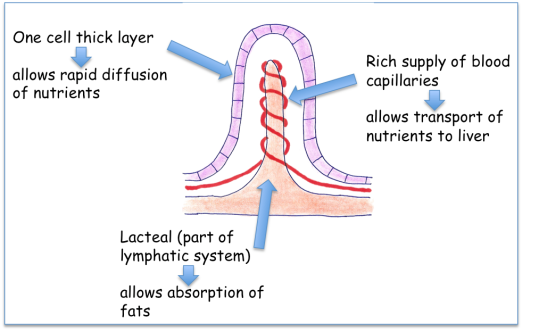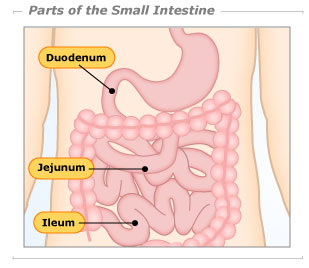Tagged: bile
Digestion of Lipids: Grade 9 Understanding for IGCSE Biology 2.29 2.30 2.31
A balanced diet will contain many different fats and oils. The commonest type of molecule in these lipids is called a triglyceride. They are made from a small molecule of glycerol attached to three fatty acids.
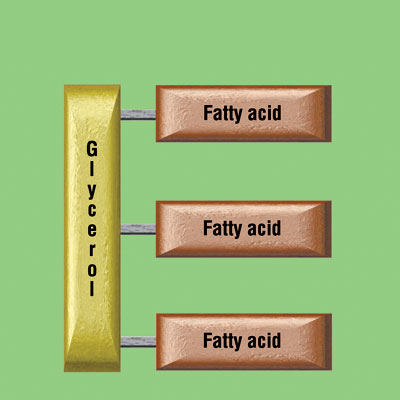
These triglycerides are too large to be absorbed in the small intestine (ileum) and so need to be broken down into their constituent parts. In the digestive system there are enzymes called lipases that can catalyse the digestion of lipids into fatty acids and glycerol.

Most digestion of lipids happens in the duodenum. The pancreas produces a lipase enzyme that mixes with the food in the duodenum. Although bile does not contain any digestive enzymes, it does have bile salts that play an important role in the digestion of lipids. Bile salts cause large fat droplets in the duodenum to change into many smaller lipid droplets – a process called emulsification. (Read my post on bile if you want more details here….)
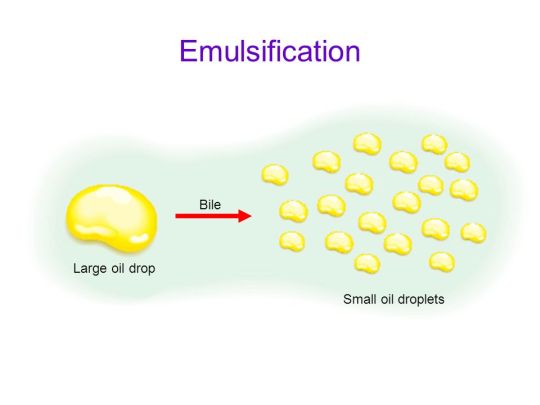
Fatty acids and glycerol molecules are small enough to cross the epithelium in the villus in the ileum. This absorption of fatty acids and glycerol is slightly different to the other products of digestion as they do not pass immediately into the blood. They are assembled immediately into structures called chylomicrons and these move into the single, blind-ended tube in the villus called a lacteal. The lacteals merge together into lymph vessels that eventually empty into the blood in the neck. (Please read my post on absorption in the small intestine to read more about this)
Bile: A* Grade 9 Understanding for IGCSE Biology 2.30 2.31
The liver is the largest internal organ and plays over 500 different roles in the body. Many functions are to do with the processing of various chemicals such as carbohydrates, amino acids and lipids. The liver also removes alcohol and other drugs from the bloodstream: this is why alcoholics often suffer from liver disease.
But one function of the liver that you need to understand in detail concerns its role in the digestive system. The liver cells produce a green liquid called bile which is stored in a sac underneath the liver called the gall bladder. Bile can pass from the gall bladder down the bile duct and as shown in the diagram below, it then mixes with the contents of the duodenum (small intestine) soon after the acidic chyme leaves the stomach.
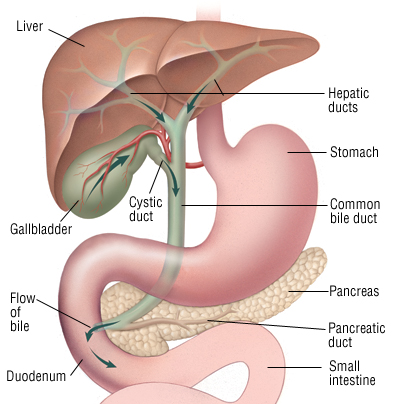
What is in bile?
Bile contains a mixture of chemicals. It has an alkaline substance (hydrogencarbonate ions) which helps to neutralise the chyme as it leaves the stomach. Remember the pH of the stomach contents is around pH1-2 and in the duodenum, there is a pH of around pH7.5. The difference in pH is due to the alkali present in bile and pancreatic juice. Bile also contains excretory molecules called bile pigments. These are waste molecules from the liver that have been made from the breakdown of haemoglobin. And finally there are the bile salts. These play an important role in the digestion of lipids in the duodenum.
How do bile salts improve digestion of lipids in the duodenum?
The duodenum is where many digestive reactions happen in the body. This is because the pancreatic juice contains many enzymes, all of which catalyse a specific digestive reaction. One such enzyme is lipase and this enzyme catalyses the following reaction:
lipids + water ——> glycerol and fatty acids

Fatty acids and glycerol are small enough molecules to be absorbed into the villi in the ileum. They pass into the lacteal in the centre of each villus to be carried around the body in the lymphatic system.
But the problem is that in the duodenum, the lipid molecules will exist as large droplets. Large droplets of fat/oil will have a reduced surface area for lipase to bind to and so the rate of digestion of the lipid would be slow. But bile salts interact with the lipid droplet causing a few large droplets to be broken down into dozens of tiny droplets. This is called emulsification and while it does not chemically alter the lipid, it does make it easier for lipase to break it down. Lipase and bile salts together break down lipids much faster than lipase alone.
Final key point: there are no digestive enzymes in bile. But in spite of this, bile plays a crucial role in the digestion of lipid droplets in the duodenum.

Small Intestine: Grade 9 Understanding for IGCSE Biology 2.32
The first part of the small intestine, called the duodenum is principally involved in digestion. Large insoluble food molecules such as proteins, lipids and starch are chemically broken down into smaller molecules in reactions catalysed by digestive enzymes.
This post will look at the longer regions of the small intestine, the jejunum and ileum. There are some digestive reactions that happen here but the main function of these parts of the intestine is the absorption of the smaller products of digestion into the body.
You should understand already which molecules are produced as products of digestion: glucose from the digestion of carbohydrates, amino acids from the breakdown of proteins and fatty acids and glycerol from the digestion of triglyceride lipids. (see my post on digestion) These then are the molecules that diffuse from the intestine into the body in the small intestine.
How is the structure of the small intestine adapted for absorption?
The main idea here is that the lining of these parts of the small intestine has a very large surface area. The intestine is long, the wall is ridged and the lining (called the epithelium) has many thousands of tiny projections called villi. Each villus is 1-3mm long but the effect is to increase the surface area for absorption by many hundreds of times.
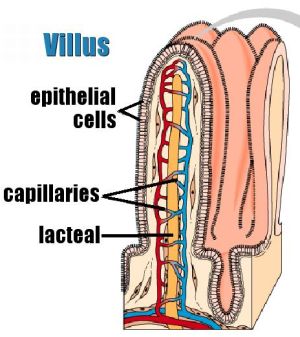
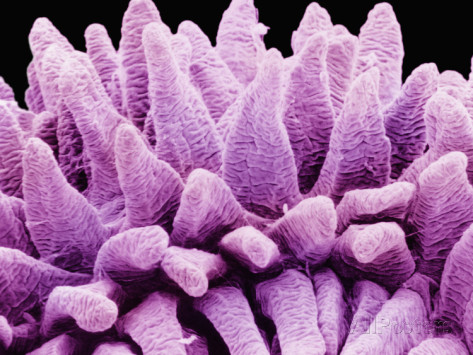
These epithelial cells have a cell membrane which is folded into many thousands of tiny structures called microvilli. Microvilli (or a brush border) can only be seem with an electron microscope and act to increase the surface area still further.
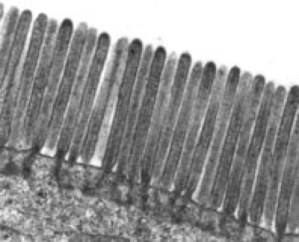
The cells that line the villus are called epithelial cells and are found in a layer that is just one cell thick. This reduces the distance the products of digestion have to move across to be absorbed.
Each villus contains a dense network of blood capillaries. This means that glucose and amino acids can easily diffuse into the blood and then be taken away from the small intestine to the liver in the hepatic portal vein. There is also a blind-ended single tube called a lacteal in each villus. This tube forms part of the lymphatic system and is used to transport fatty acids and glycerol away from the small intestine.
